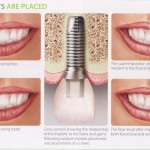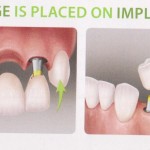How Are Implants Placed?
One of the most exciting advancements in dentistry has been the dental implant. It’s a natural-looking, usually permanent, secure way of restoring or replacing missing teeth that has allowed millions of people who have been unable to chew for years to regain the chewing ability of their youth. In most cases, implants are titanium anchor posts that are surgically placed in the jawbone and capped with a full crown or bridge.
Who Can Place Implants?
Implant treatment is usually provided by a team including a surgeon (a periodontist or an oral surgeon) to place the implant, a dental laboratory technician to fabricate the crown, and a restorative dentist to place the crown. However, some general dentists are trained in implant dentistry and perform both the surgical and the restorative phases of treatment. Although implant dentistry is not a formal dental speciality, many practitioners have undergone extensive implant training, and some even limit their practices to implant treatment.
IMPLANT TREATMENT STEP-BY-STEP
Implant treatment can be immediate or take several months depending on your situation. Following are the basic phases and steps of treatment, although they’ll vary based on your particular needs. The surgical phase is typically performed in two stages, although it can sometimes be done in one.
PRESURGICAL PHASE
- Your mouth is examined thoroughly, and x-rays of your head, jaw, and teeth may be taken. Today many dental surgeons use a CT scan, which provides the dentist with a 3-D look at the site where the implant will be placed. This can help the surgeon to plan where the implant will be placed into your bone with great precision.
- Impressions of your teeth and/or ridges are made to help the dentist determine exactly where the implants should be placed.
- Occasionally, blood tests as well as a medical examination may be required prior to implant placement to determine your overall health status and predict the success of treatment.
SURGICAL PHASE (TWO-STAGE SURGERY)
An incision is made in the gum, the implant is placed, and the gum tissue is stitched back into place. This can be done with a local anesthetic in the dentist’s office or under sedation or general anesthesia in a hospital or clinic. In certain patients, the implant can be placed directly in the bone without the need for incision.
Following surgery, you’ll probably experience some swelling and discoloration of the gums as well as some discomfort, which can be relieved with medication. Within a few days, the gums should return to normal. To allow the implants to heal properly, a soft diet is recommended for 4 to 6 weeks.
The second stage of surgery is usually performed 2 to 6 months after the first in an outpatient setting. The dentist numbs the areas with local aneasthetic, makes an incision in the gums to expose the implants, and connects abutments to the implants.
The gums are stitched into place and a temporary restoration placed on the abutment. At times, additional gum surgery may be required for esthetic purposes. If you’re missing all of your teeth, a comfortable dressing or your old dentures (reline with a soft material) will be placed over the abutments to promote healing and reduce discomfort.
Impressions may be made so that the dentists know where to position your new teeth. Your dentist should instruct you about how to keep the abutments clean.
POST SURGICAL PHASE
About a month later, your new teeth are fitted. In some cases, they’re attached to a metal framework. In other cases, the artificial teeth may be attached to natural or stand alone.
Several checkups are scheduled during the following year so your dentist can ensure that your implants are functioning properly. After that, you’ll need regular maintenance checkups. Follow-up x-rays are taken regularly.
A NEW TOOTH IN ONE DAY.
Immediate loading is an alternative way of placing implants in which the implant and the crown are placed in the same visit. This eliminates the need for a second surgical phase and greatly speeds up the implant placement process. If you have a tooth that needs to be extracted, ask your dentist or implant specialist if you’re a candidate for immediate loading.
WHAT IF YOU DON’T HAVE ENOUGH BONE?
There’s good news for patients who previously have been told that they don’t have sufficient bone implant placement. If the surgeon, after evaluating your bone quantity and quality on x-rays or a CT scan, believes there’s not enough bone for implant placement, he or she may recommend a bone graft.
A bone graft involves taking a small amount of synthetic or processed cadaver bone or your own bone from another part of your body (such as your jaw or hip) to replace lost bone elsewhere. After a period of healing, sufficient bone should be available for implant placement.
IMPLANTS AREN’T FOR EVERYONE
Dental implants aren’t the right restorative choice for every patient. Poor or questionable candidates for implants include those who have:
1: Insufficient healthy jawbone to support an implant and poor prognosis for bone grafting.
2: Gum disease.
3: Medical conditions that affect the body’s ability to heal and repair itself, such as diabetes and cancer.
4: Conditions affecting the ability to use the hands and arms.
5: Lack of commitment to thorough home care and professional maintenance.
6: Osteoporosis that is being treated with bisphosphonates.
7: A smoking habit.


